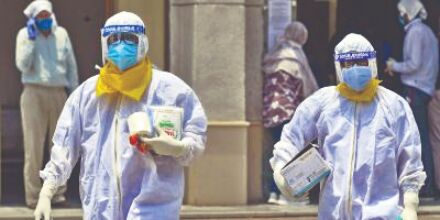2020: How Delhi suffered, battled pandemic of the century

New Delhi: The COVID-19 pandemic left Delhi bruised and battered in 2020 but the city fought back with an army of 'corona warriors' and strategic decisions in the war against the faceless enemy.
The first case of COVID-19 in Delhi was reported on March 1 when a businessman from east Delhi, who had returned from Italy, tested positive. On April 11, the number of cases crossed the 1,000-mark, totalling 1,069, while the death count on that day was 19. Active cases on April 27 when the tally crossed the 3,000-mark stood at 2,177.
While the successive lockdowns sought to throw a veil of protection from outside, many facilities, including the LNJP Hospital, Rajiv Gandhi Super Speciality Hospital (RGSSH) and GTB Hospital were converted into dedicated COVID-19 hospitals, and private facilities were also told to reserve beds, to treat swelling number of patients.
On June 23, the national capital reported its first wave of the infection, with 3,947 cases, the highest single-day spike till then.
Delhi went into a war mode, with government efforts to combat the pandemic being led by 'corona warriors' who donned white lab coats, PPE kits in hospitals and ambulances, and khaki in the streets as police personnel worked day and night to ensure the compliance of lockdown.
As streets became deserted in COVID-induced lockdown, photos of clear blue skies and cleaner Yamuna sprang up on social media, the appreciation of nature and immediate surroundings and the home itself, helped ease the psychological burden of the pandemic, the worst in the last 100 years after the Spanish Flu of 1918-19.
Balconies turned into makeshift performance venues for many in Delhi too, drawing inspiration from people of Italy who sang their blues away by facing their fears head-on. Italy was one of the worst-affected country at that time of the year.
The fate of suffering in the European country was also somewhat mirrored in Delhi, as the national capital on June 24 became the city worst-hit by the coronavirus pandemic in India, eclipsing Mumbai, with the infection tally breaching the 70,000-mark.
The city government's policy of home isolation mild and asymptomatic cases of COVID-19 faced a few bureaucratic hiccups in the beginning stage but later it proved to be winner.
When the national capital saw abrupt rise of positive cases, Union Home Minister Amit Shah personally took charge to improve Delhi's healthcare facilities and curb the spread of coronavirus.
Delhi Health Minister Satyendar Jain in an interview in early September had asserted that home isolation policy had proved a "game changer" in taming the surge in June, a strategy the city government would continue to pursue.
While Delhi government significantly ramped up testing capacity from August onwards, when it averaged about 18,000 daily, to 56,000 in October and nearly 90,000 in December, the virus continued to play havoc in between.
In this period, Delhi battled the second and third waves of the pandemic in September (over 4,000 daily cases multiple times) and November
respectively, the latter being the worst this year, but the city known for its resilience, soldiered on and eventually manage to surmount it.



